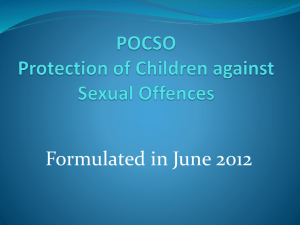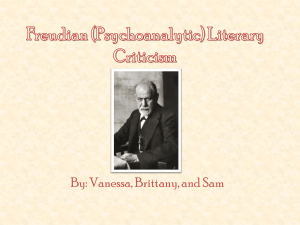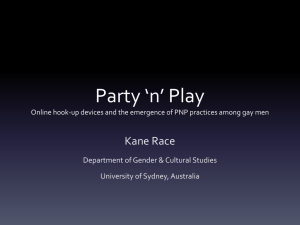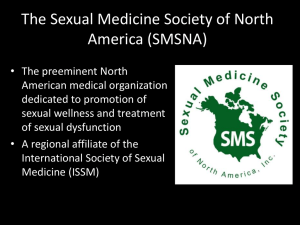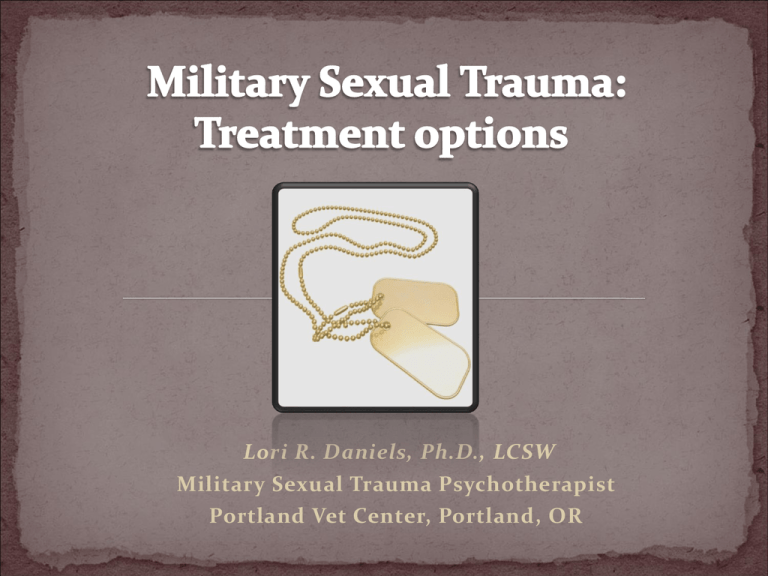
Lori R. Daniels, Ph.D., LCSW
Military Sexual Trauma Psychotherapist
Portland Vet Center, Portland, OR
All statements made are strictly the
presenter’s and do not reflect the thoughts,
opinions, nor policies of the Dept. of Veterans
Affairs.
Acknowledgements: numerous researchers
whose work is cited in this presentation; MST
resources provided by the DVA for use in
community presentations/information.
MALES
FEMALES
Can express anger
Cannot express anger the
Are not expected to
continue previous
domestic duties
Have a larger support
network (more men)
Are assumed to be
veterans
same way – not acceptable
Are expected to return to
previous domestic duties
without problems
Have a very limited social
support network (less
women)
Are not assumed to be
veterans (@ vet
gatherings)
Defined: Physical assault of a sexual nature,
battery of a sexual nature, or sexual
harassment….repeated, unsolicited verbal or
physical contact of a sexual nature which is
threatening in character… that occurred
while a veteran was serving on active duty or
active duty for training.
- (Title 38, US Code 1720D)
FEMALES
Sexual harassment
54%; Sexual assault 3%
◦ (Annual rates; DoD, 2002)
Sexual harassment
60%; Sexual assault
23%
◦ (Anytime during service;
Street et al., 2003)
Sexual harassment
55%; Sexual assault
23%
◦ (Anytime during service;
Skinner et al., 2000)
MALES
Sexual harassment
23%; Sexual assault 1%
◦ (Annual rates; DoD, 2002)
Sexual harassment
27%; Sexual assault
3%
◦ (Anytime during service;
Street et al., 2003)
Civilian Sexual Trauma
24% of women
experience sexual
trauma (13-30%)
10% of men experience
sexual trauma(3-16%)
55-70% are sexually
harassed (21 studies;
Goldzweig et al., 2006)
11-48% are assaulted
Military Sexual Trauma
55% of women
experience sexual
trauma
14% of men
experience sexual
trauma
Military training in aggression
High concentration of males and females
ages 18-40
High use of alcohol
Victims and perpetrators may have premilitary abuse or dysfunctional families
Victims are a “captive audience”
Therefore – it’s a pressure cooker
Military culture of camaraderie
Victims continue to live among the
perpetrator within a unit or battalion or duty
station
Fear of reporting (no-win)
Two methods – restricted and nonrestricted
◦ “Was it rape?”
◦ “Was it my fault?”
◦ “Will anyone believe me?”
◦ “Will I be blamed, labeled, ostracized?”
◦ “If I report it, will it ruin my career?”
◦ “Everyone else likes (the perpetrator), so what
will they think of me?”
◦ “I’m not sleeping at night, am constantly scared,
can’t trust others, and wanting everyone to leave
me alone.”
(Katz, 2009)
4x more likely to develop PTSD than for those who
experience combat stress only
3x more likely to be depressed than combat stress
only
2x more likely to abuse substances than combat
stress only
Assoc with obesity, eating disorders, heart attacks,
chronic pain and increased medical conditions
across all systems
Diffic keeping jobs; involvement with abusive
relationships - homelessness
Obsessive thinking about how it should
have been (incident)
Self-blame and/or elevated level of
responsibility
Fixation on controlling environment and
symptoms
Lack of trust in self/others
Victim paradigm
Nightmares (threatening)
Waiting for next bad thing
Interpersonal conflicts
Difficulties communicating
Problems with intimacy & attachment
High tolerance for dysfunctional
relationships
Hyper sexual (men: to prove masculinity)
or non sexual (too many associations with
trauma)
Male
Cultural
Sexual
Assault
Military
Culture
Existential problems
Sexual Trauma evokes everything
that masculinity rejects:
Fear
Shame
Vulnerability
Helplessness/submission
Intense, inescapable emotions
Rape Myth: Real Men Don’t Get Raped
So, if a male is raped, normal male gender
identity is no longer an option
...Conclusion: “If I was raped, I can’t be a
real man”
It happened because…
I gave off some gay signal
I was too effeminate
I was too trusting/eager to make friends
I was being punished for being gay
I was physically weak-- I should have been
heavier, stronger, bigger, etc.
Rape Myth:
Male Rape is Homosexual Sex
So if I was raped…
o“Am I gay?”
o“I must be gay.”
o“I am gay and I can’t face it.”
• Little public awareness
• Stigma
• Male identity/values: Weak and unmanly to…
• Be victimized
• Need help
• Seek help
• Talk about victimization
• Share vulnerable feelings
(common Responses to disclosure to non-MST
therapists)
o “Are you gay?”
o “Why didn’t you fight him off?”
o “You’re not a real man.”
o “I don’t want to have anything to do with you.”
o “Don’t tell anyone, and it will eventually
disappear.”
o Silence, denial
Individual psychotherapy focusing using a
mixture of client-centered, insight-oriented,
emotion-focused,interventions: Integrative
Therapy
Including: therapeutic processing of traumatic
memories;
Psychoeducation: sleep hygiene; relationship
counseling; substance abuse treatment;
group psychotherapy;
medications
Evidence exists in many forms.
Betrayal, mistrust, difficulty with relationships, fear of
disclosure, shame/guilt, detachment from full range of
emotions, low self-esteem…
Are technique-focused psychotherapy interventions the best
choices for complex issues?
Converges different solutions with evid-based with
different problems requirements;
Consistently identifies new ways of conceptualizing and
conducting psychotherapy that go beyond confines of a
single school of intervention/theoretical orientation;
“meta-psychology”: does not offer ONE model of
psychopathology or theory of personality, therefore does
not limit mechanisms through which psychotherapy works
Embraces therapeutic value of many systems of
psychotherapy
Posits that many tx methods have valuable place in repertoire
GESTALT THERAPY
CLIENT-CENTERED THERAPY
EXISTENTIAL THERAPY
EXPOSURE TECHNIQUES
EMOTION-FOCUSED THERAPY
Trauma focus
Responsibility (Scurfield; Kubany)
PSYCHOEDUCATION: Relationships,
sleep/nightmares, communication
SOCIAL SUPPORT
ETC.
Outcome in psychotherapy might be due to factors that all
therapies have in common, i.e., characteristics of therapists, resources of
the client, potency of therapeutic relationship (versus techniques specific
to theoretical orientation. (Rosenzweig, 1936); Dodo Bird
conjecture
Even therapies based on radically different values show
similar affect sizes in terms of successful outcome, in studies
utilizing varying outcome measures.
Variance in outcome is attributed to therapeutic factors =
30%; variance attributed to techniques = 15%; expectancy
fracture (placebo) = 15%. (Lambert, 1992)
Evidence strongly supports a contextual versus a medical
model of therapy in which specific ingredients are
important only as aspects of the entire healing context
(Wampold, 2001, p. 217).
“Common factors research”:
Upholds RELATIONSHIP, as opposed to techniques, as
the core facilitative agent of change. (Wampold, 2001)
Therapeutic alliance support (Hovarth, 1995)
Rapport and empathy (Bohart & Greenberg, 1997)
Client’s capacity for self-healing (Bohart & Tallman,
1999)
Expressed emotion (Gendlin, 1996; Greenberg, Rice, &
Elliott, 1993)
Gestalt: manner of relating and the execution of
techniques must be tailored to each patient’s needs, not to
diagnostic categories… Therapy will be ineffective if the
patient is made to conform to the system rather than the
system adjust to the patient…
Mechanisms of gestalt include:
Focusing techniques that allow attention to be on the
experience of the client and therapist; here and now; key
moments: interruptions of process, build pt’s capacity to work
through emotions.
Enactment via role-playing, psychodrama, empty-chair
Body Awareness, breathing;
Loosening thinking – alternative possibilities; putting words
to sensations.
Gestalt: randomized-control studies not necessarily fit for
measuring gestalt techniques;
Experiential therapies which overlap with gestalt, processexperiential (directive): more effective than either pure
client-centered approach or cognitive and behavioral
treatments. (Greenberg, Elliott, and Lietaer, 1994); emptychair technique effective in resolving unfinished emotional
issues with signif others (Greenberg, 1982; Greenberg &
Dompierre, 1981; Greenberg & Higgins, 1980, Paivio &
Greenberg, 1992).
Research relevant for gestalt needs to account for
importance of therapeutic relationship
Gestalt has wide range of interventions, therefore more diff
to study quantitatively in terms of clinical practice.
Review of data from 74 published research studies on tx
process and outcome; tests of efficacy on data for approx
4500 patients treated in clinical practice; 3000 treated with
gestalt, 1500 control Ss; multiple dx;
Discusses comparisons conducted by Elliott (2001; 2004)
and suggests that relative to # of measurements used,
signif results were found more freq for humanistic
therapies than behavioral and psychodynamic. Effects
largest for gestalt therapy with symptoms of depression,
anxiety and phobias (Strumpfel, 2006);
Effectiveness of gestalt in areas of social
/relations/interpersonal functions; marked improvement
in establishing personal contact, sustaining relationships,
and managing aggression/conflicts (Strumpfel, 2004,
2006);
Meta-analysis, experiential confrontation (focus) process in
session is strong predictor for positive therapeutic outcome
(Orlinsky, Grawe, and Parks, 1994).
Therapist provides unconditional positive regard and
empathic understanding of client’s expressions from
viewpoint of the internal frame of reference of the client
(Rogers, 1957, 1959b); opposite: un-genuine; client’s
perception of therapist’s congruence = effective or
ineffective therapy;
Non-directiveness: Tx recognizes client’s presentation,
accepts this, does not provide answers ore reassurance;
client is regarded as the best ‘expert’
By attending to and understanding a client’s narrative, it
validates the subjective context – which can strengthen this
context and allow future access (Zimring, 2000).
Creating a space
to build trust
Where survivor can be ‘safe’
To disclose and process changes
since traumatic event
To feel comfortable and not
judged
Educating about sexual assault responses
that are to be expected (PTSD sx)
Process underlying “stuck” issues
Issues of self-blame
Staying in reality
Addressing distorted schemas of “I
could have stopped this from
happening (to me)”



